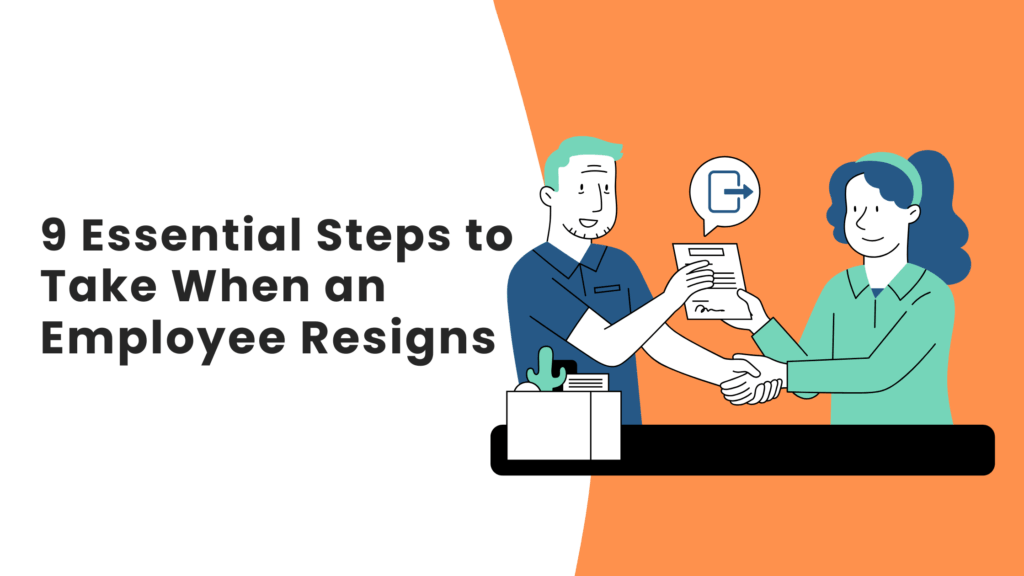9 Things You Should Do When an Employee Resigns

Employee resignations are inevitable in any growing organization. Handling them with professionalism and structure not only protects your business but also leaves a positive impression on departing employees and the rest of your team.
Here’s a comprehensive, step-by-step offboarding checklist for 2025 to ensure a smooth transition for everyone involved.
Step 1: Acknowledge and Document the Resignation
-
Promptly acknowledge receipt of the resignation in writing.
-
Request a formal resignation letter stating the last working day and whether the notice period will be served or replaced with leave.
-
Notify relevant stakeholders (HR, IT, payroll, reporting manager) about the resignation.
Step 2: Communicate the Departure Internally
-
Inform the employee’s team, cross-functional partners, and senior management about the exit.
-
For customer-facing roles, communicate the transition plan to key clients or external stakeholders.
Step 3: Plan the Transition and Knowledge Transfer
-
Identify pending projects and critical responsibilities.
-
Assign handover tasks and schedule knowledge transfer sessions.
-
Allow sufficient time for a smooth handover before the last working day.
Step 4: Reclaim Company Property
-
Prepare a checklist of assigned assets (laptops, ID cards, mobile phones, credit cards, documents, etc.).
-
Schedule a meeting to collect items and have the employee sign an acknowledgment of return.
Step 5: Revoke System and Facility Access
-
Deactivate IT accounts, email, cloud tools, and internal databases.
-
Disable access badges, biometric systems, and remote VPNs.
-
Inform third-party vendors to revoke access to any external portals.
Step 6: Conduct the Exit Interview
-
Schedule a structured exit interview close to the last day.
-
Use open-ended questions to gather honest feedback on work culture and reasons for leaving.
-
Document insights for future HR improvements.
Step 7: Settle Final Payments and Complete Documentation
-
Process all dues: salary, leave encashment, bonuses, gratuity, etc.
-
Obtain “No Dues” certificates from all departments.
-
Issue relieving and experience letters, and any additional requested documents.
Step 8: Update Company Records and Organizational Charts
-
Update internal directories and organizational charts.
-
Remove the employee from communication tools, groups, and distribution lists.
Step 9: Conduct a Security and Confidentiality Debrief
-
Remind the employee of ongoing confidentiality obligations.
-
For sensitive roles, conduct a formal security debriefing.
Step 10: Offer Support for Future Opportunities
-
Offer to provide reference letters or certifications.
-
Maintain a positive relationship for future collaboration or rehiring.
✅ Offboarding Checklist Summary
-
Acknowledge and document resignation
-
Notify all relevant stakeholders
-
Communicate departure internally and externally
-
Plan knowledge transfer and transition
-
Collect all company property
-
Revoke all IT and facility access
-
Conduct exit interview and gather feedback
-
Settle final payments and issue documents
-
Update company records and directories
-
Conduct security debrief and confidentiality reminder
-
Offer references and support for future opportunities
Frequently Asked Questions (FAQ)
Q1: What is an employee exit process?
An offboarding process is a structured series of steps followed when an employee leaves, ensuring compliance, asset protection, and brand integrity.
Q2: Why is a formal resignation letter important?
It officially records the intent to resign, confirms the last working day, and ensures legal and HR compliance.
Q3: What should be included in an offboarding checklist?
Key steps include resignation management, access revocation, knowledge transfer, asset return, final payments, and feedback collection.
Q4: How do you ensure data security during offboarding?
Immediately revoke access, change passwords, and remove the employee from systems. Conduct a security debrief for sensitive roles.
Q5: What is the purpose of an exit interview?
To gain honest insights about work experience, management, and reasons for resignation—valuable for improving retention.
Q6: What documents should be given to the departing employee?
Include the relieving letter, experience letter, full-and-final settlement details, and references if requested.
Q7: How do you communicate an employee’s departure to the team?
Notify the team, leadership, and clients as appropriate. Share the transition plan to ensure operational continuity.
Q8: What are the legal requirements for offboarding in India?
Ensure all statutory dues are paid, and required documents issued, in accordance with Indian labor laws.
✍️ Final Thoughts
A well-structured offboarding process protects your organization, ensures legal compliance, and maintains a positive employer brand. Use this checklist to make every employee exit a respectful, smooth, and efficient experience.